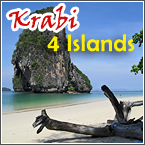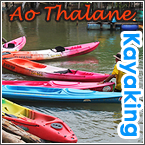Hoi Chak Teen
July 12, 2010 by admin
Filed under Local Delicacy
Comments Off on Hoi Chak Teen
![]() ‘ FEET PULLING SHELLS ‘
‘ FEET PULLING SHELLS ‘
Known as “Hoi Chak Teen” in Thai or as a type of wing-shell that belongs to the Strombus Canxarium family. It looks like a conch but is smaller and brown in color. Its special characteristic is its dark brown walking legs which are referred to as “feet” or “teen” (in informal Thai). It is also known to the Indonesian in Riau Archipelagos as ” Gong Gong.” This local seashell is recognize as a seafood delicacy in Krabi. It is commonly found at the river mouth near sandy banks such as areas around Koh Jum and Koh Siboya. Harvesting is only done by the local fishermen twice a month during the receding spring tide. To prepare the dish, the wing shell is soaked in salty water for about half an hour. A few crushed chilies are added to the water to make it spicy. The wing shell then begins to move, pushing its feet out and expelling the mud from inside. It is rinsed several times and then put in to a pot of cold water. The pot is then put on the stove to boil and when the water gets warm, the wing shell pushes its feet out. As soon as it is cooked, it is ready to be served. To eat the morsel, you pull the feet and the mollusk will come out. You can also use a toothpick to reach into the shell and pull all the meat out of the shell in one go. It is eaten with a dip made of garlic, chilies, sugar, lime juice and fish sauce. The shells are also made into decorative items for the home or sold as souvenirs.
Read more
Thailand’s favourite fish
March 28, 2010 by admin
Filed under Local Delicacy
‘Pla thu’ has a prime place in the culinary culture of Thailand
If there is a fish that is close to the heart of Central Thailand’s culinary tradition it is probably the pla thu, a type of mackerel that goes ideally with nam phrik kapi, the iconic chilli dip sauce. But there are several varieties of pla thu, including types found off the China coast and in Indonesian waters. The one that Thais like best, and which inhabits the Gulf of Thailand, is not especially big and is notable for its oily meat and its appetising aroma and flavour. Its life cycle involves a certain amount of travel. The mother lays her eggs in southern Thai waters where there are rocky reefs to protect them. When they hatch, the tiny fry gradually make their way to the Gulf of Thailand, and the closer they get to the part of the gulf that they are seeking, with its muddy bottom, the more food they find. It abounds in the muddy-bottomed sea off of Samut Songkhram and Phetchaburi, where the fish grow to full size and their meat reaches maximum quality. It is in these places that the best and tastiest pla thu are caught. The fish that aren’t caught by fishermen return to the South to breed and the cycle is repeated. Since the entire life cycle takes place in Thai waters, this variety of pla thu is considered to be a Thai fish. It is one fish that is eaten by Thais in every part of the country.
















